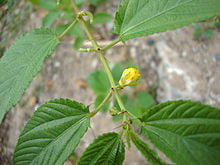Corchorus olitorius

e973Jute mallow or nalta jute (Corchorus olitorius, also known as “Jew’s mallow”,[1] “tossa jute”, “bush okra”, “krinkrin”, “etinyung”, “molokhia”, and “West African sorrel”, among many other local names, often invoking the most important traits[2]) is a species of shrub in the family Malvaceae. Together with C. capsularis it is the primary source of jute fiber.[3][4] The leaves and young fruits are used as a vegetable, the dried leaves are used for tea and as a soup thickener, and the seeds are edible.[3]
It is unclear whether Corchorus olitorius originated in Africa or in Asia. Some authorities consider that it comes from the Indo-Burmese area or from India, along with several other related species. Others point out that there is a greater genetic variation in Africa and a larger number of wild species in the genus Corchorus. Wherever it originated, it has been under cultivation for a very long time in both continents and probably grows, wild or as a crop, in every country in tropical Africa.[6]
In classical antiquity, Pliny recorded that jute plants were used as food in Ancient Egypt.[7] It may have also been cultivated by the Jews in the Near East, which gives the plant its name.[7]
